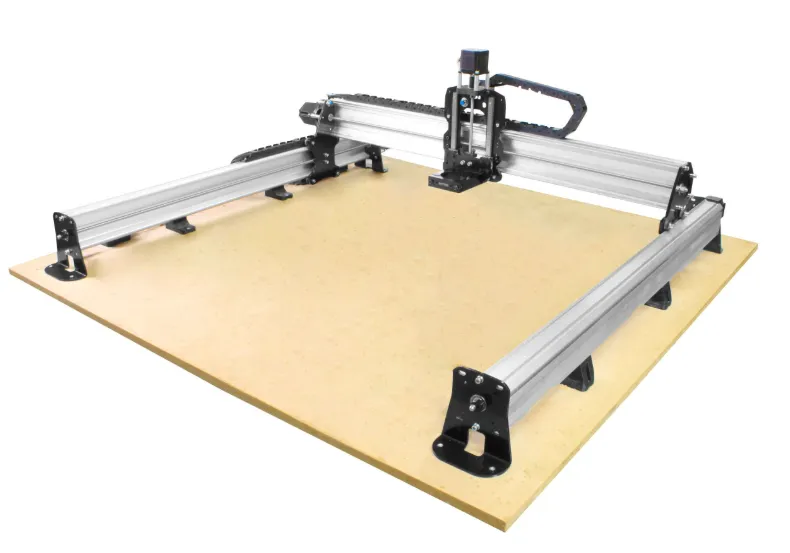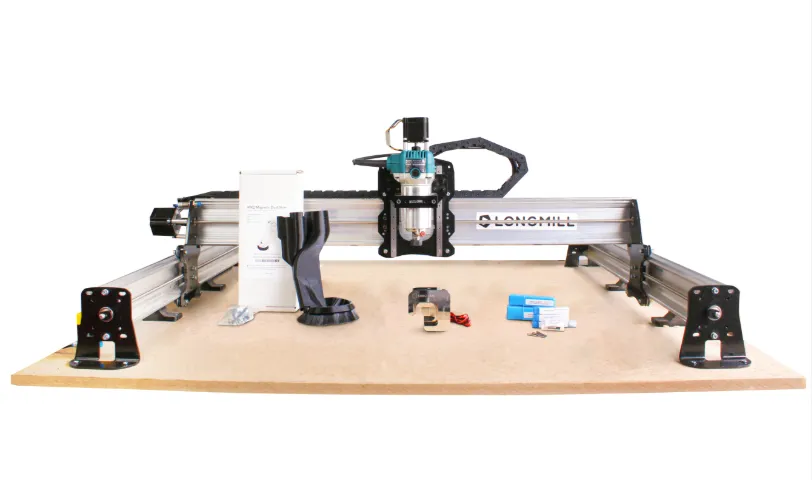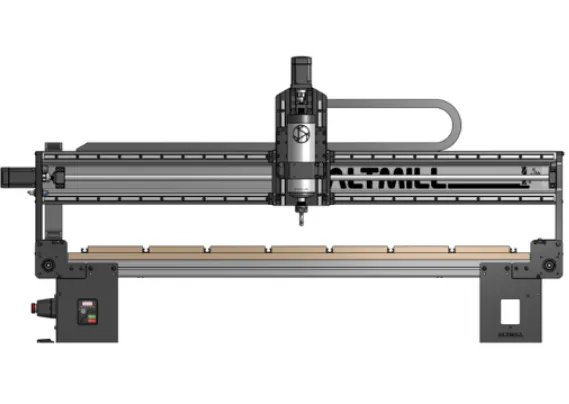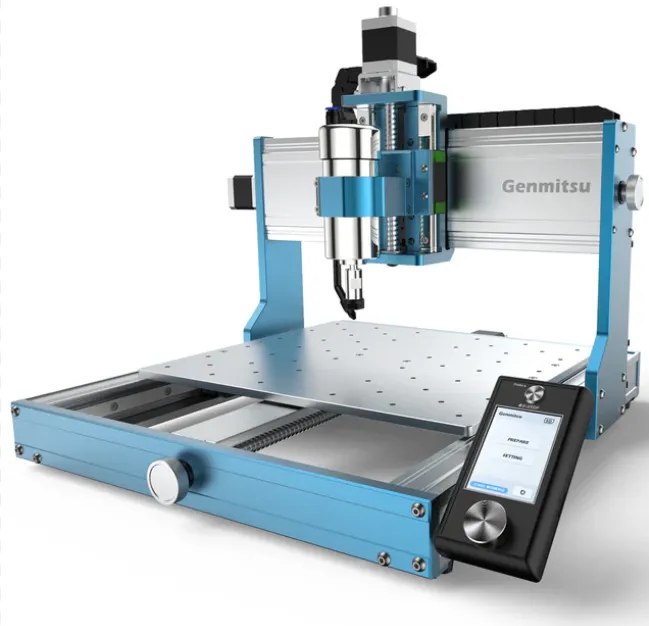The LongMill CNC system represents a thoughtfully engineered desktop machining platform designed to bridge the gap between hobbyist-grade routers and industrial CNC equipment, offering a 30×30-inch work area within a compact footprint that fits standard workshop spaces. Constructed with heavy-duty aluminum extrusions and steel reinforced joints, the machine maintains structural rigidity capable of handling cutting forces up to 150N during wood and aluminum machining operations. Its unique open-frame design eliminates the need for complex belt tensioning systems seen in many comparable machines, instead utilizing precision-ground ACME lead screws with anti-backlash nuts that deliver positioning accuracy within ±0.005 inches (±0.127mm) across all axes. The standard configuration includes NEMA 23 stepper motors generating 175 oz-in of holding torque, controlled through an offline GRBL-based controller that operates independently of host computers once programs are loaded – a feature particularly valued by users running extended jobs without dedicated shop computers.
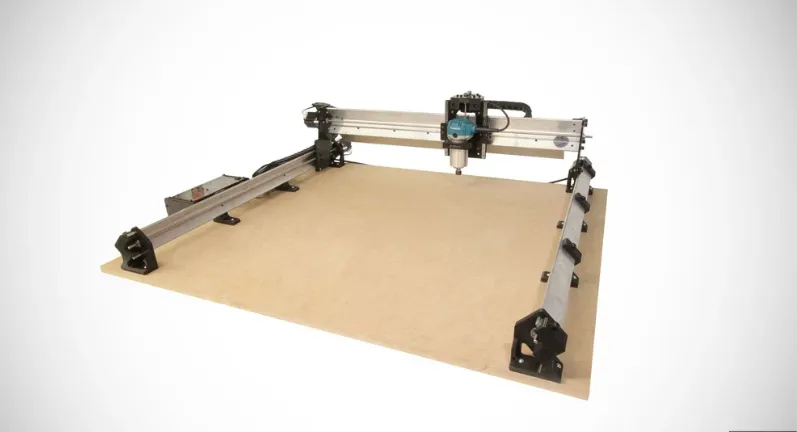 Electrical and motion systems on the LongMill demonstrate careful design considerations for accessibility and safety. The 48V DC power supply drives all three axes simultaneously, with current-adjustable stepper drivers allowing fine-tuning of motor performance to match specific material requirements. An integrated emergency stop circuit and spindle relay provide failsafe protection, while the modular wiring design simplifies maintenance and troubleshooting. The machine’s motion parameters are optimized for real-world use, with maximum travel speeds of 150 inches per minute (3810mm/min) in rapids and recommended cutting speeds between 30-100 IPM (762-2540mm/min) depending on material and tooling. Users can upgrade to a 1.5kW water-cooled spindle (operating at 8,000-24,000 RPM) for improved performance in metals, though the standard router mount accommodates most 1/4-inch collet trim routers for wood and plastic applications. The control software accepts standard G-code from any CAM program, with the manufacturer providing customized post-processors for optimal toolpath execution on the LongMill’s specific kinematics.
Electrical and motion systems on the LongMill demonstrate careful design considerations for accessibility and safety. The 48V DC power supply drives all three axes simultaneously, with current-adjustable stepper drivers allowing fine-tuning of motor performance to match specific material requirements. An integrated emergency stop circuit and spindle relay provide failsafe protection, while the modular wiring design simplifies maintenance and troubleshooting. The machine’s motion parameters are optimized for real-world use, with maximum travel speeds of 150 inches per minute (3810mm/min) in rapids and recommended cutting speeds between 30-100 IPM (762-2540mm/min) depending on material and tooling. Users can upgrade to a 1.5kW water-cooled spindle (operating at 8,000-24,000 RPM) for improved performance in metals, though the standard router mount accommodates most 1/4-inch collet trim routers for wood and plastic applications. The control software accepts standard G-code from any CAM program, with the manufacturer providing customized post-processors for optimal toolpath execution on the LongMill’s specific kinematics.
Material capabilities span a practical range for small-scale production, with the machine demonstrating particular effectiveness in hardwood machining (maple, oak) at depths of cut up to 1/4 inch (6.35mm) per pass using 1/4-inch end mills. Aluminum machining requires more conservative parameters – typically 1/16 to 1/8 inch (1.6-3.2mm) depth of cut at reduced feed rates – but produces clean results when using appropriate climb milling techniques and lubricants. The open-frame construction facilitates machining of oversized materials when needed, with many users employing sacrificial spoil boards for through-cutting operations on sheet goods up to 1.5 inches (38mm) thick. Workholding solutions include T-track compatible mounting surfaces for commercial clamps, while innovative users have implemented vacuum hold-down systems for production runs of smaller parts. Dust collection ports positioned near the cutting area help maintain visibility and shop cleanliness during extended operation.
Technical innovations in the LongMill design address common pain points of benchtop CNC machines. The Z-axis incorporates a unique counterbalance mechanism that eliminates backlash without increasing motor load, maintaining precision during intricate 3D carving operations. All linear motion components are fully enclosed within the extrusion profiles, protecting critical surfaces from dust accumulation while retaining easy access for lubrication. The machine’s rigid gantry design minimizes harmonic vibrations that typically plague aluminum-framed routers, allowing cleaner cuts in hard materials. An optional laser engraving module expands capabilities to include fine detail work on leather, acrylic, and wood surfaces, though with different setup requirements than traditional router operations. The control system’s offline operation capability proves particularly valuable in educational environments or shared workshop spaces where dedicated computer stations aren’t practical.
Industrial applications of the LongMill often focus on small-batch production where its balance of size and capability delivers economic value. Woodworkers produce custom cabinetry components, decorative inlays, and musical instrument parts with feature resolutions down to 0.01 inches (0.254mm). Sign makers utilize the machine for dimensional lettering and relief carvings in various materials. Prototyping shops value its ability to quickly iterate designs in aluminum and engineering plastics before committing to expensive production tooling. Educational institutions incorporate LongMills into STEM programs, where the machine’s safety features (low-voltage operation, emergency stop) and mechanical transparency provide excellent learning platforms for CNC fundamentals. Small manufacturers employ fleets of LongMills for distributed production of specialized components, taking advantage of the system’s consistency across multiple units. The machine’s open architecture also encourages customization, with an active user community sharing modifications ranging from enhanced dust collection to automated tool changing systems.
Performance characteristics reflect careful engineering trade-offs appropriate for the machine’s market position. Cutting tests in 6061 aluminum demonstrate achievable tolerances of ±0.003 inches (±0.076mm) for critical dimensions when using proper fixturing and toolpaths. Surface finish quality in hardwoods approaches that of professional cabinet shop equipment when employing sharp compression bits and optimal feed rates. The machine’s stiffness allows effective use of smaller diameter tools (down to 1/16 inch or 1.6mm) for detailed work, though with appropriately reduced depth of cut parameters. Thermal stability proves adequate for most workshop environments, though users machining tight-tolerance metal parts often implement warm-up routines to normalize temperatures across the frame. Electrical noise immunity exceeds that of many comparable systems, with proper grounding practices preventing the interference issues that sometimes plague stepper-driven CNC routers.
Maintenance requirements emphasize user-serviceable design, with lubrication points clearly marked and mechanical components selected for durability in small shop environments. The ACME screws require periodic cleaning and application of dry lubricant, while linear bearings benefit from occasional adjustment to maintain smooth motion. Electrical connections utilize industrial-grade connectors that withstand vibration better than typical hobbyist components. The manufacturer provides comprehensive documentation including torque specifications for all critical fasteners and troubleshooting guides for common operational scenarios. Many wear components are standard industrial parts, ensuring long-term availability without proprietary supply chain dependencies.
Future developments for the LongMill platform focus on enhancing accessibility without compromising its core value proposition. Wireless control options are in development to further simplify machine setup and operation. Improved spindle cooling systems aim to extend continuous run times for production environments. The manufacturer actively collaborates with CAM software developers to create optimized toolpath strategies for the machine’s specific performance characteristics. An expanding ecosystem of jigs and fixtures designed specifically for the LongMill’s work area demonstrates the platform’s growing adoption across diverse applications. These ongoing refinements maintain the system’s relevance as user requirements evolve while preserving the fundamental design principles that made the original LongMill distinctive in the crowded field of benchtop CNC solutions.
The LongMill’s success stems from its balanced approach to precision, durability, and accessibility – offering approximately 80% of industrial CNC router capability at 20% of the cost and space requirements. This strategic positioning has created a unique niche in the market, serving serious makers, small businesses, and educational programs that require dependable performance without industrial-scale infrastructure. As digital fabrication continues democratizing manufacturing capabilities, machines like the LongMill play an increasingly important role in empowering individuals and small organizations to bring professional-quality products from concept to reality. The system’s design philosophy – emphasizing mechanical simplicity, open compatibility, and thoughtful engineering over proprietary complexity – suggests a sustainable path for future development that will likely influence the next generation of accessible CNC equipment across the industry.

